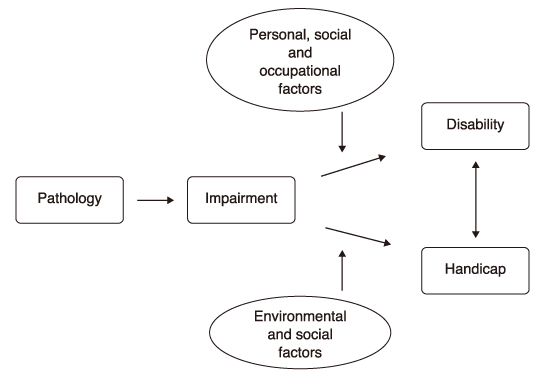J Korean Med Assoc.
2009 Jun;52(6):552-557. 10.5124/jkma.2009.52.6.552.
The Method of Impairment Evaluation
- Affiliations
-
- 1Department of Orthopedic Surgery, The Catholic University of Korea College of Medicine, Korea. ygchung@catholic.ac.kr
- KMID: 2065049
- DOI: http://doi.org/10.5124/jkma.2009.52.6.552
Abstract
- An impairment is defined as "a loss, loss of use, or derangement of any body part, organ system or organ function". The impairment evaluation should be performed by physicians. To determine permanent impairment associated with medical condition a standard method should be used. It is a general principle that an evaluation of permanent impairment only be performed when the physician considers the person to have reached a state of maximum medical improvement. Maximum medical improvement is considered when the person's condition has been medically stable and is unlikely to change by more than 3% of whole body impairment within the next 12 months. The physician must use the entire clinical skill and judgment to perform the proper impairment evaluation. A report of the evaluation of permanent impairment should be accurate, comprehensive and fair. The physicians are reminded that they have a duty to act in an ethical, professional and considerate manner when examining the person for the purpose of assessing the permanent impairment.
Keyword
MeSH Terms
Figure
Reference
-
1. Kim CH. A study on the reform of the physical disability evaluation system. Indep Med Exam. 2007. 4:35–43.2. Lee KS. Independent medical examination, concepts and needs. Indep Med Exam. 2005. 2:1–4.3. Mooney V. Impairment, disability, and handicap. Clin Orthop. 1987. 221:14–25.
Article4. Lim KS. The fundamental of compensation medicine. 2000. 4th ed. Seoul: Jungangmoonhwa;40–119.5. McBride ED. Disability evaluation and principles of treatment of compensable injuries. 1963. 6th ed. Philadelphia: JB Lippincott;68–103.6. American Medical Association. Guides to the evaluation of permanent impairment. 2005. 5th ed. Chicago: AMA press;17–24.7. Lee KS. Impairment evaluation and independent medical examination. 2002. 1st Ed. Seoul: Jungangmoonhwa;34–67.8. Korean Orthopaedic Association. Disability evaluation. 2005. 1st Ed. Seoul: Seoul Med-Media;13–27.9. Lee KS. Medical considerations in reparation and compensation. 1992. 1st Ed. Seoul: Jinsoo Publishing;16–23.10. Ministry for Health, Welfare and Family Affairs. The Disability Act, Enforcement Rule, An annexed list 1. 2003.11. Lee SD. How to write medical document. Indep Med Exam. 2005. 2:17–21.12. Ko Y. The role of Korean Academy of Independent Medical Examiners-disability evaluation. Indep Med Exam. 2004. 1:4–7.13. Lee KS. Impairment evaluation and independent medical examination. 2002. 1st Ed. Seoul: Jungangmoonhwa;67–86.14. Lee KS. Medical considerations in reparation and compensation. 1992. 1st Ed. Seoul: Jinsoo Publishing;122–132.
- Full Text Links
- Actions
-
Cited
- CITED
-
- Close
- Share
- Similar articles
-
- A Comparative Study on Evaluation of Physical Impairment Among Revised Evaluation by Medical Association, McBride Disablitlity Evaluation and Evaluation of Permanent Impairment by American Medical Association
- New Guides to the Evaluation of Korean Hearing Impairment in 2012
- A Korean Academy of Medical Sciences Guides for the Evaluation of Permanent Impairment
- Evaluation of Physical Impairment
- Assesment of Physical Impairment and Disability Evaluation: Problem of Present System and Design for Better System


